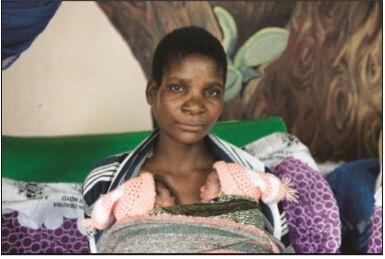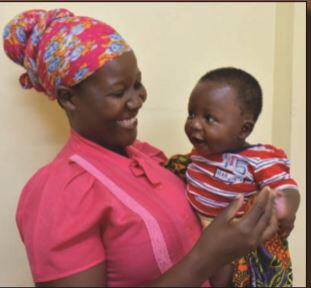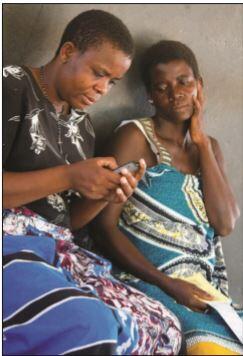
A dim ray of sunlight shines through the window of the Post-Partum Room at Lwanda Health Center in Machinjiri, Blantyre.
In the small space, which is also used as a storeroom for drugs and other medical supplies, midwife Lorina Msowa, 41, attends to a mother and her new born baby.

Due to the lack of electricity the night before, Msowa and her colleagues struggled to care for the pregnant woman who had been rushed to the Health Center for an emergency delivery. This time, they were able to save the lives of the mother and her baby.
“It was a lucky night for us because the mother did not have any complications, so she gave birth safely,” says Msowa.
Had there been complications, the lack of adequate facilities would have made her work difficult.
Last month, Lorina helped in delivering 8 at the center which caters to over 2,000 residents of the Machinjiri.
A few of those women arrived at the Health Center with complications, and they had to be transferred to Queens Elizabeth Central Hospital, a major referral infirmary which is at 14.5 kilometers away from Lwanda Health Center.
Maternal and child health care facilities at most health centres across Malawi are in dire need of basic infrastructure and support to operate efficiently. Every night, the Lwanda Health Center lies in darkness. The nurses and other health workers on duty improvise by using light from their cell phones.

Jessie Thawe, who lives in the populous slum of Machinjiri explains, “As soon as I learned I was pregnant back in September 2016, it was like a switch turned on, and I started seeing story after story about the risks associated with childbirth and motherhood. It felt like a cruel trick.
I knew for me to remain calm and confident throughout the process, I would need to seek a health care provider who would provide warm, focused and passionate care.
It was hard for me to gather pregnancy information as a working class lady; my only source of information was my cell phone which I could use to query for information on google website and always remained connected through-out the nine months pregnancy period.
“During the pregnancy with my first child, I had a friend who was equally pregnant but died few minutes after giving birth. Tragically, her baby died too. We lost mother and child. Her husband has not fully recovered from the tragedies because it was his first child. Another lady in my church was recently buried.”
She was just thirty-one years old and married for only three years. Incidentally, the pregnancy was her first and she did not survive it.
No woman should die while giving life. It is an anomaly that must stop. Families who are expecting good news should not be hounded with death news.

Parents expecting a grandchild should not be drowned with the losses of not just the expected grandchild but their own daughter or daughter-in-law as well. Such tragedies should be fought on all fronts. Society must decide that the lives of these women are worth saving like Malawi’s Health Minister Atupele Muluzi, said: “Women are not dying of diseases we can’t treat… They are dying because societies have yet to make the decision that their lives are worth saving.”
And I verily agree with him.
Maternal death is a serious challenge and everyone should be concerned because every statistic is someone’s mother or wife, sister or friend, neighbor or colleague.
Every time we hear the phrase maternal mortality, we should be wary and worried because the death represents another loss for everyone.
Every number in Malawi’s maternal mortality rate is another tragedy, another sad story that could have been and should be avoided.
The maternal mortality ratio (MMR) is the ratio of the number of maternal deaths during a given time per 100,000 live births during the same time-period.
A maternal death refers to a female death from any cause related to or aggravated by pregnancy or its management (excluding accidental or incidental causes) during pregnancy and childbirth or within 42 days of termination of pregnancy, irrespective of the duration and site of the pregnancy.
Maternal Mortality may sound like a bogus term simply referring to maternal deaths but within those two words are the silent and untold miseries of many millions.

The former United Nations (UN) Secretary-General, Ban Ki-Moon, few years ago, convened a meeting of health leaders and experts from over 30 countries to set a global plan of action to ensure that no woman, newborn, child or adolescent dies from preventable.
The meeting identified interventions needed to accelerate progress towards improving the lives of women, children and adolescents.
The UN Sustainable Development Goals (SDGs), particularly SDG-3, sets the stage for global innovations and inclusive interventions for collective and focused actions towards the promotion of good health and well-being of children and men.
Malawi’s efforts at achieving good health and well-being must necessarily focus on curbing perennial maternal and child mortality at both the institutional and community levels.
Though maternal health care has improved over the past 20 years in Malawi, the pace has rather been slow.
There is the need to put in extra efforts and interventions to enable Malawi to achieve the SDG-3 target of good health and well-being.
The maternal mortality rate reduced from 984 to 100,000 in 2004 to 675 to 100,000 in 2010 with an increase in women delivering at health centres from 57.2% in 2004 to 73% in 2010.
There has also been a reduction in pneumonia case fatality from 18.7% in 2000 to 5.7% in 2008 and an increase in the proportion of children with acute respiratory infections taken to health facilities for treatment from 19.6% in 2004 to 70.3% in 2010.
Immunization coverage is high: 81% of the children aged 12-23 months old were fully vaccinated in 2010. This is an increase in coverage of 26% since the 2004 DHS.
There has also been an increase in coverage of the estimated population in need of ART from 3% in 2004 to 67% in 2011.
Every day, their lives are lost — direct causes of maternal deaths in Malawi being hemorrhage, hypertension, sepsis, and abortion. Major indirect causes are severe anemia, malaria, HIV/AIDS, and tuberculosis. The tragedy is that almost all of these deaths could be prevented.
There are hopes that maternal and child mortality will further reduce based on the government’s new intervention such as free maternal health services, re-positioning of family planning, and increased training of midwives and partnership with development agencies.

One such partner working with Malawi government is Baobab Health a Malawian Trust. Founded in 2001, the organisation dedicated its efforts to revolutionizing the use of technology in developing world’s health care environment.
Baobab Health develops applications using open standards web technology and releases the applications using open source licenses so that others too can benefit from these innovations.
Behind the brains they produce computer based applications in electronic Medical Record systems.
With main focus of use of ICTs tools, to make maternal health information available and accessible to pregnant women living in hard to reach communities in Malawi.
Innovation and expansion
In November May, 2017, Baobab Health Trust – BHT connected Chipini, Ngwelero, Mayaka, and Domasi Health Centers to ICT equipment – national ART/OPD electronic medical records system.
These tools were meant to facilitate maternal and child health promotion; by raising awareness on good maternal and child health practices through easy dissemination of vital information to pregnant and lactating mothers to keep them and their babies healthy.
Eliot Makondetsa an IT expert says: “Creating power-point presentations helps to easily communicate to mothers and families. Pictures of breastfeeding mothers help explain the importance of good attachment and exclusive breastfeeding to the mothers.”
ICTs, therefore, will strengthen information dissemination and keep pregnant women and entire communities up to date on positive pregnancy and child care practices. ICTs provide convenient means of sharing and receiving information and will help to overcome some cultural practices that prevent pregnant women from delivering at health facilities, the major contributory factor to maternal and child mortality in the country.















Mortality must be reduced
maternal and child mortality issues are very alarming across Africa even some part of Asia and minimal in USA/Europe.
This is nice researched article write more of such. Greetings from Edinburg UK